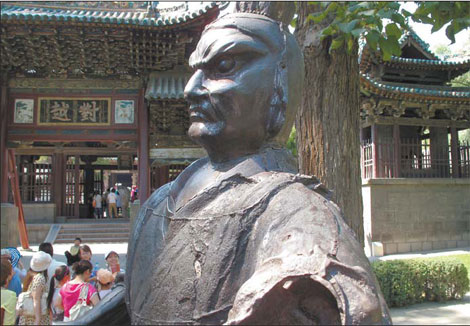The iron men of Jinci
|
|
|
One of the four iron statues in Jinci Temple stands broken but enlivened by a colorful folk tale. Raymond Zhou / China Daily |
There were three young men who worked in a temple and formed a male bond, the kind typical in ancient China. They addressed one another as "brother". They shared a voracious appetite as they were young and hardworking. But the monks in the temple were stingy and grudged the food they were consuming.
"Maybe this is not the place for us. Maybe we should venture elsewhere," they said as they discussed their escape plan. On a stormy night, the three made a run for their freedom. But two of them were caught by the monks and got such a severe beating their scalps cracked.
The lone escapee ran and ran in the dark - until he was stopped by the Yellow River. He wanted to cross the river to get to the north. There was a bridge made of ropes of straw and underneath were raging rapids. As he hesitated, he saw an old man passing by. "Wise man, do you think I'll be able to go across the bridge?" he asked.
"Who can crush this bridge other than the iron man in Jinci Temple?" answered the old man.
As he wondered whether to proceed, his two "brothers" were beaten half dead back in the temple. They figured it must have been the fourth man in their dorm who had informed on them. That guy, in the southwest corner, was from another province and did not join their little clique. As he came under suspicion, the southwestern guy found it more and more difficult to live peacefully with the others. He had to flee, too, he thought.
A senior monk noticed his unease and dispatched a subordinate to stand guard. One night, the youngster saw the southwestern guy slipping out and called his superior. The senior monk rushed in, armed with an axe. Exasperated, he slammed it on the escapee's right foot three times and put him in chains.
This is the folk origin of the four "iron men" in Jinci Temple, as the four statues are nicknamed. The one in the southwest corner was originally cast in 1097 by someone outside the province. Scars remain on his right foot, possibly from a robbery attempt. The two statues in the north both had their heads remolded - in 1423 and 1926 respectively. The one in the northeast, who in the folktale version fled all the way to the Yellow River and was halted by a cryptic sage, was completely remade in 1913.
This imaginative interpretation of the four statues adds a Toy Story-like layer of richness to the already colorful history of Jinci Temple.
The statues, about two meters tall, stand on a square platform made of brick. The balustrades are low enough to function as seats. People can pose with them or even touch them. There are other versions about their origin: They were meant as gods to fight floods; they were symbols of the invading Jin army's celebration of victory, hence "Jin men"; they were guards of the treasury.
The truth is more mundane: They were gifts from local aristocrats who either sought blessing for something or had their prayers answered and therefore felt the urge to express gratitude.
Jinci Temple, 25 km from downtown Taiyuan, is unlike any other temple. For one thing, it is not symmetrical in layout. It has the charm of a private garden in southern China. There is the Mirror Terrace, which is a stage for live performances. There is the Memorial Archway and the Offerings Hall, dating from 1168, with its primitive-looking beams and see-through walls. The oldest man-made structure is the 19-m tall Saint Mother Hall, built in 984, surrounded and supported by dragon-encircled pillars.
However, the half-fallen cypress tree next to the hall is said to be 3,000 years old, going all the way to the mythical origins of the temple. In the early years of Western Zhou Dynasty (c. 11th century-771 BC) the king conquered a northern territory named Tang. One day, he cut a leaf from a parasol tree in the shape of a jade ornament, gave it to his younger brother and quipped: "Now you own the Tang", a homonym and a pun for the new territory. When the young prince was set to embark on his dukedom, the king went back on his word. But the court historian retorted: "Kings do not joke. Whatever they say must be fulfilled."
The young prince is historically known as Tang Shuyu, tang for the territory and shu is an archaic term for younger brother. He ruled with wisdom and developed irrigation and agriculture. After his death, a temple was built in his honor. Later it was renamed Jin because the river Jin flows through the land. Now Jin is short for Shanxi and the temple has become a landmark that embodies history through its many additions and renovations.
 0
0 








Go to Forum >>0 Comments